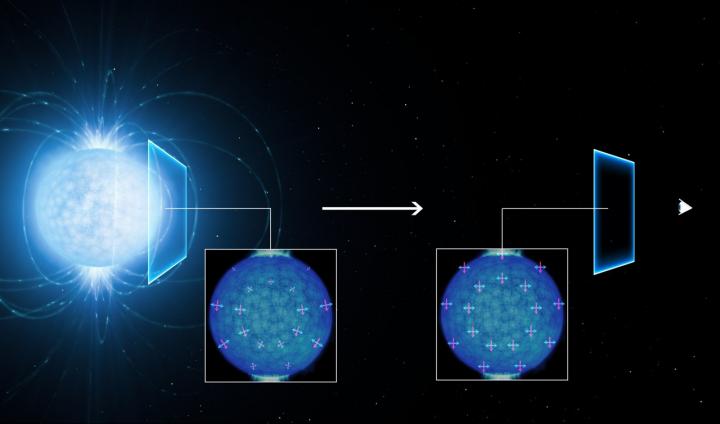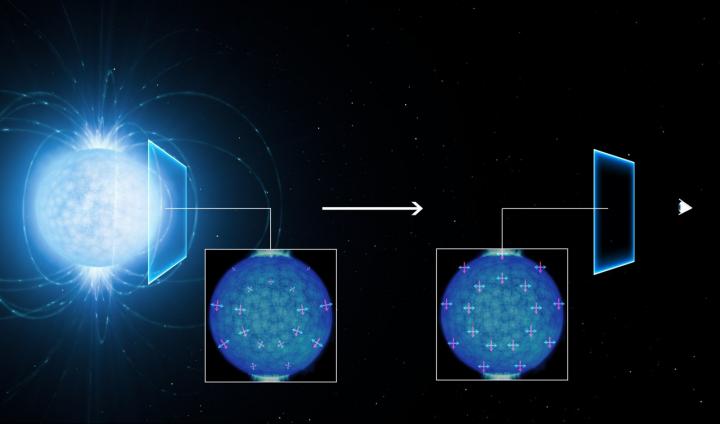
Credit: ESO/L. Calçada
A team led by Roberto Mignani from INAF Milan (Italy) and from the University of Zielona Gora (Poland), used ESO's Very Large Telescope (VLT) at the Paranal Observatory in Chile to observe the neutron star RX J1856.5-3754, about 400 light-years from Earth [1].
Despite being amongst the closest neutron stars, its extreme dimness meant the astronomers could only observe the star with visible light using the FORS2 instrument on the VLT, at the limits of current telescope technology.
Neutron stars are the very dense remnant cores of massive stars — at least 10 times more massive than our Sun — that have exploded as supernovae at the ends of their lives. They also have extreme magnetic fields, billions of times stronger than that of the Sun, that permeate their outer surface and surroundings.
These fields are so strong that they even affect the properties of the empty space around the star. Normally a vacuum is thought of as completely empty, and light can travel through it without being changed. But in quantum electrodynamics (QED), the quantum theory describing the interaction between photons and charged particles such as electrons, space is full of virtual particles that appear and vanish all the time. Very strong magnetic fields can modify this space so that it affects the polarisation of light passing through it.
Mignani explains: "According to QED, a highly magnetised vacuum behaves as a prism for the propagation of light, an effect known as vacuum birefringence."
Among the many predictions of QED, however, vacuum birefringence so far lacked a direct experimental demonstration. Attempts to detect it in the laboratory have not yet succeeded in the 80 years since it was predicted in a paper by Werner Heisenberg (of uncertainty principle fame) and Hans Heinrich Euler.
"This effect can be detected only in the presence of enormously strong magnetic fields, such as those around neutron stars. This shows, once more, that neutron stars are invaluable laboratories in which to study the fundamental laws of nature." says Roberto Turolla (University of Padua, Italy).
After careful analysis of the VLT data, Mignani and his team detected linear polarisation — at a significant degree of around 16% — that they say is likely due to the boosting effect of vacuum birefringence occurring in the area of empty space surrounding RX J1856.5-3754 [2].
Vincenzo Testa (INAF, Rome, Italy) comments: "This is the faintest object for which polarisation has ever been measured. It required one of the largest and most efficient telescopes in the world, the VLT, and accurate data analysis techniques to enhance the signal from such a faint star."
"The high linear polarisation that we measured with the VLT can't be easily explained by our models unless the vacuum birefringence effects predicted by QED are included," adds Mignani.
"This VLT study is the very first observational support for predictions of these kinds of QED effects arising in extremely strong magnetic fields," remarks Silvia Zane (UCL/MSSL, UK).
Mignani is excited about further improvements to this area of study that could come about with more advanced telescopes: "Polarisation measurements with the next generation of telescopes, such as ESO's European Extremely Large Telescope, could play a crucial role in testing QED predictions of vacuum birefringence effects around many more neutron stars."
"This measurement, made for the first time now in visible light, also paves the way to similar measurements to be carried out at X-ray wavelengths," adds Kinwah Wu (UCL/MSSL, UK).
###
Notes
[1] This object is part of the group of neutron stars known as the Magnificent Seven. They are known as isolated neutron stars (INS), which have no stellar companions, do not emit radio waves (like pulsars), and are not surrounded by progenitor supernova material.
[2] There are other processes that can polarise starlight as it travels through space. The team carefully reviewed other possibilities — for example polarisation created by scattering off dust grains — but consider it unlikely that they produced the polarisation signal observed.
More information
This research was presented in the paper entitled "Evidence for vacuum birefringence from the first optical polarimetry measurement of the isolated neutron star RX J1856.5?3754", by R. Mignani et al., to appear in Monthly Notices of the Royal Astronomical Society.
The team is composed of R.P. Mignani (INAF – Istituto di Astrofisica Spaziale e Fisica Cosmica Milano, Milano, Italy; Janusz Gil Institute of Astronomy, University of Zielona Góra, Zielona Góra, Poland), V. Testa (INAF – Osservatorio Astronomico di Roma, Monteporzio, Italy), D. González Caniulef (Mullard Space Science Laboratory, University College London, UK), R. Taverna (Dipartimento di Fisica e Astronomia, Università di Padova, Padova, Italy), R. Turolla (Dipartimento di Fisica e Astronomia, Università di Padova, Padova, Italy; Mullard Space Science Laboratory, University College London, UK), S. Zane (Mullard Space Science Laboratory, University College London, UK) and K. Wu (Mullard Space Science Laboratory, University College London, UK).
ESO is the foremost intergovernmental astronomy organisation in Europe and the world's most productive ground-based astronomical observatory by far. It is supported by 16 countries: Austria, Belgium, Brazil, the Czech Republic, Denmark, France, Finland, Germany, Italy, the Netherlands, Poland, Portugal, Spain, Sweden, Switzerland and the United Kingdom, along with the host state of Chile. ESO carries out an ambitious programme focused on the design, construction and operation of powerful ground-based observing facilities enabling astronomers to make important scientific discoveries. ESO also plays a leading role in promoting and organising cooperation in astronomical research. ESO operates three unique world-class observing sites in Chile: La Silla, Paranal and Chajnantor. At Paranal, ESO operates the Very Large Telescope, the world's most advanced visible-light astronomical observatory and two survey telescopes. VISTA works in the infrared and is the world's largest survey telescope and the VLT Survey Telescope is the largest telescope designed to exclusively survey the skies in visible light. ESO is a major partner in ALMA, the largest astronomical project in existence. And on Cerro Armazones, close to Paranal, ESO is building the 39-metre European Extremely Large Telescope, the E-ELT, which will become "the world's biggest eye on the sky".
Links
* Research paper – http://www.eso.org/public/archives/releases/sciencepapers/eso1641/eso1641a.pdf
* Photos of the VLT – http://www.eso.org/public/images/archive/category/paranal/
Contacts
Roberto Mignani
INAF – Istituto di Astrofisica Spaziale e Fisica Cosmica Milano
Milan, Italy
Tel: +39 02 23699 347
Cell: +39 328 9685465
Email: [email protected]
Vincenzo Testa
INAF – Osservatorio Astronomico di Roma
Monteporzio Catone, Italy
Tel: +39 06 9428 6482
Email: [email protected]
Roberto Turolla
University of Padova
Padova, Italy
Tel: +39-049-8277139
Email: [email protected]
Richard Hook
ESO Public Information Officer
Garching bei München, Germany
Tel: +49 89 3200 6655
Cell: +49 151 1537 3591
Email: [email protected]
Media Contact
Richard Hook
[email protected]
49-893-200-6655
@ESO
http://www.eso.org
############
Story Source: Materials provided by Scienmag





